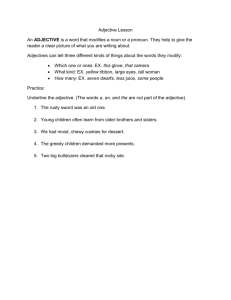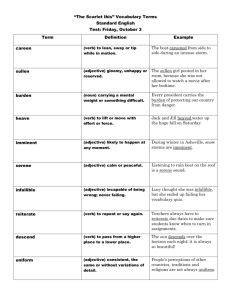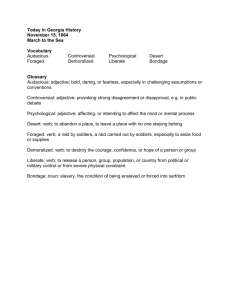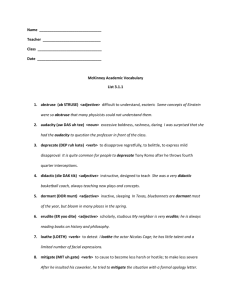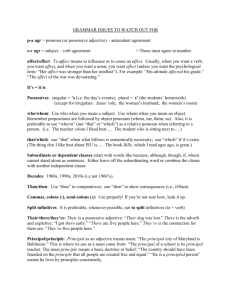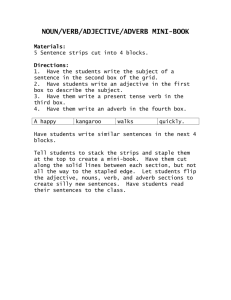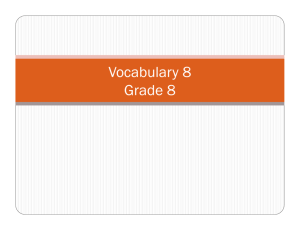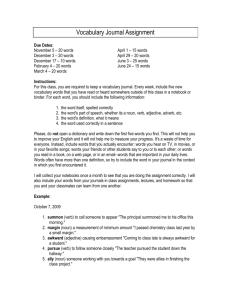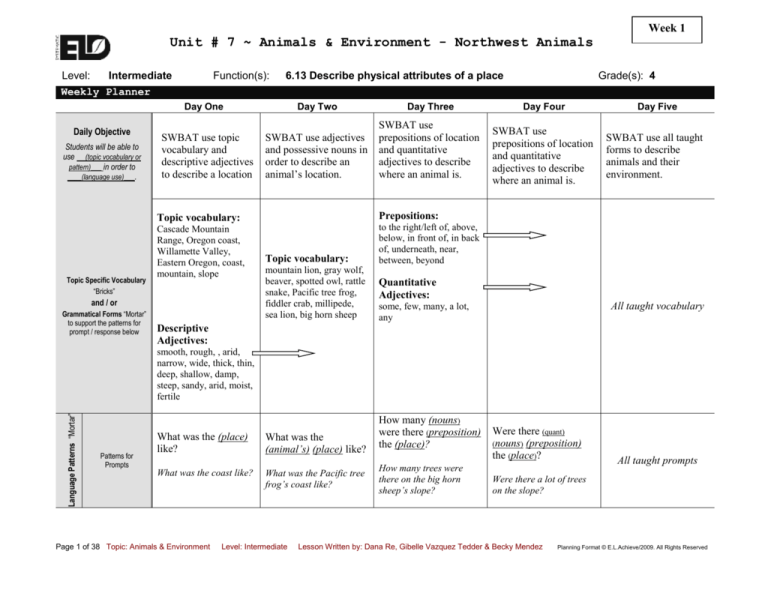
Week 1
Unit # 7 ~ Animals & Environment - Northwest Animals
Intermediate
Level:
Weekly Planner
Function(s):
6.13 Describe physical attributes of a place
Day One
Daily Objective
Students will be able to
use (topic vocabulary or
pattern)___ in order to
____(language use)___.
Topic Specific Vocabulary
“Bricks”
SWBAT use topic
vocabulary and
descriptive adjectives
to describe a location
Day Three
SWBAT use adjectives
and possessive nouns in
order to describe an
animal’s location.
SWBAT use
prepositions of location
and quantitative
adjectives to describe
where an animal is.
Topic vocabulary:
Prepositions:
Cascade Mountain
Range, Oregon coast,
Willamette Valley,
Eastern Oregon, coast,
mountain, slope
to the right/left of, above,
below, in front of, in back
of, underneath, near,
between, beyond
and / or
Grammatical Forms “Mortar”
to support the patterns for
prompt / response below
Day Two
Topic vocabulary:
mountain lion, gray wolf,
beaver, spotted owl, rattle
snake, Pacific tree frog,
fiddler crab, millipede,
sea lion, big horn sheep
Grade(s): 4
Day Four
SWBAT use
prepositions of location
and quantitative
adjectives to describe
where an animal is.
Day Five
SWBAT use all taught
forms to describe
animals and their
environment.
Quantitative
Adjectives:
All taught vocabulary
some, few, many, a lot,
any
Descriptive
Adjectives:
Language Patterns “Mortar”
smooth, rough, , arid,
narrow, wide, thick, thin,
deep, shallow, damp,
steep, sandy, arid, moist,
fertile
Patterns for
Prompts
What was the (place)
like?
What was the
(animal’s) (place) like?
What was the coast like?
What was the Pacific tree
frog’s coast like?
Page 1 of 38 Topic: Animals & Environment
Level: Intermediate
How many (nouns)
were there (preposition)
the (place)?
How many trees were
there on the big horn
sheep’s slope?
Were there (quant)
(nouns) (preposition)
the (place)?
All taught prompts
Were there a lot of trees
on the slope?
Lesson Written by: Dana Re, Gibelle Vazquez Tedder & Becky Mendez
Planning Format © E.L.Achieve/2009. All Rights Reserved
Unit # 7 ~ Animals & Environment - Northwest Animals
The (place) was
(adjective) and
(adjective).
Patterns for
Responses
The (adjective) (place) Its (place) was
(adjective) and
was (adjective).
(adjective).
The coast was sandy and
moist.
The sandy coast was
moist.
Structured Language
Practice (Tab 4)
How will students produce
language - at least 50% of
lesson?
How will you gather evidence
of student learning?
Materials
Plus, Routines for Teaching
and Practicing (Tab 4)
The (animal)’s (place)
was (adjective) and
(adjective).
The Pacific tree frog’s
coast was sandy and
moist. Its coast was sandy
and moist.
There were (quat)
(noun) (preposition) the
(animal)’s (place).
There were some trees on
the big horn sheep’s
slope.
There were some trees on
its slope.
Lines of
Communication (4.46)
A/B partners with
animal picture cards
A/B partners with
animal picture cards
One line has the picture
cards and asks the question
to the other line. The other
line answers, then they
switch.
A asks B the question based
on the picture card in their
hand and B answers. Then
switch
A asks B the question based
on the picture card in their
hand and B answers. Then
switch
Write in language log
Write in language log
Write in language log
Background, pocket
chart, sentence strips,
chart paper, language
journal
Animal picture cards
(from Carousel of
A/B cards, Background, Ideas), small scenes &
pocket chart, sentence
pictures, spinners,
strips, chart paper,
Background, pocket
language journal
chart, sentence strips/
chart paper, language
journal
Page 2 of 38 Topic: Animals & Environment
Level: Intermediate
Yes there were (quant)
(noun) (preposition) the
(place).
There weren’t (quant)
(noun) (preposition)
(place).
All taught responses
Yes, there were a lot of
trees on the slope.
There weren’t a lot of
trees on the slope. There
were a few trees.
Dialogue Bubbles with
A/B partners to practice
the prompt
Animal picture cards,
small scenes &
pictures, spinners,
Background, pocket
chart, sentence strips/
chart paper, language
journal
Lesson Written by: Dana Re, Gibelle Vazquez Tedder & Becky Mendez
Board game to practice
the prompt
Background, pocket
chart, sentence strips,
chart paper, language
journal
Planning Format © E.L.Achieve/2009. All Rights Reserved
Wrap-Up & Reflection
Opening: Bring to Life
& State Objective
Day One
3 - 6 minutes
Tell students they
will be describing
a location.
I Do It
Model New Language
I/We Do It
Model and Monitor Practice
You Do It:
Structured Independent Practice
Unit # 7 ~ Animals & Environment - Northwest Animals
5 -7 minutes
8-12 minutes
Point to each area on the poster
and tell the students the name
of each of the places.
Using the sentence frame,
introduce the descriptive
adjectives (have adjective
cards pre-made). Then stick on
word cards with adjectives
onto the poster for each area.
Echo repeat/choral responses
10 – 15 minutes
3 - 5 minutes
Lines of communication
Describe one area
of the poster in
language journal,
or orally to a
partner.
A/B partners
In language
journal, write a
sentence
describing one
animal’s place
using multiple
adjectives.
A/B partners
In language
journal, write 2-3
sentences (in
response to
teacher’s question.
The (place) was (adj) and (adj).
The (adj) (place) was (adj).
The coast was sandy and moist.
The sandy coast was moist..
Day Three
Day Two
Introduction on possessive-adding
apostrophe and s.
Choose a couple
of students to read
their journal
entries from
yesterday aloud to
the class.
Have students
share their journal
responses from
yesterday with a
partner.
The (animal)’s (place) was (adj)
and (adj).
Echo repeat/choral responses
Its (place) was (adj) and (adj).
The Pacific tree frog’s coast was
sandy and moist. Its coast was
sandy and moist.
Intro for students on
prepositions-draw on chart
paper as you fill in the
preposition. Mini lesson on
quantitative adjectives.
There were (quat) (noun) (prep)
the (animal)’s (place).
Echo repeat/choral responses
There were some trees on the big
horn sheep’s slope.
There were some trees on its
slope.
Page 3 of 38 Topic: Animals & Environment
Level: Intermediate
Lesson Written by: Dana Re, Gibelle Vazquez Tedder & Becky Mendez
Planning Format © E.L.Achieve/2009. All Rights Reserved
Unit # 7 ~ Animals & Environment - Northwest Animals
Day Five
Day Four
Continue working on sentence
frame from yesterday,
Have students
share their journal
responses from
yesterday with a
partner.
Board game using
patterns from all
week
Yes there were (quant) (noun)
(prep) the (place).
There weren’t (quant) (noun)
(prep) (place).
Echo repeat/choral responses
A/B partners with dialogue
bubbles from Blackline Master
Book
In language
journal, write 2-3
sentences (in
response to
teacher’s
questions).
Teacher models using frames
from all week to write a
paragraph about an
environment (choose a familiar
one students will know, like
their classroom)
Students will describe the
environment of the small
picture they receive.
Students will read
what they wrote to
2 other students in
the class.
Yes, there were a lot of trees on
the slope.
There weren’t a lot of trees on the
slope. There were a few trees.
Board game using patterns
from all week
Page 4 of 38 Topic: Animals & Environment
Level: Intermediate
Lesson Written by: Dana Re, Gibelle Vazquez Tedder & Becky Mendez
Planning Format © E.L.Achieve/2009. All Rights Reserved
Week 1
Unit # 7 ~ Animals & Environment - Northwest Animals
Ongoing Assessment of Language Practice
Directions: List target grammatical form(s) below. As you monitor target language practice, note whether
student is:
There weren’t
(quant) (noun)
(preposition)
(place).
Yes there were
(quant) (noun)
(preposition)
the (place).
Able to produce language independently = I
There were
(quat) (noun)
(preposition)
the (animal)’s
(place).
ELD Level(s): Intermediate
Its (place) was
(adjective) and
(adjective).
Language Function: Describe a place
The (animal)’s
(place) was
(adjective) and
(adjective).
Teacher:
Able to produce language using scaffolds = —
The (adjective)
(place) was
(adjective).
The (place) was
(adjective) and
(adjective).
Unable to produce language = 0
Notes
Date:
1.
2.
3.
4.
5.
6.
7.
8.
9.
10.
11.
12.
13.
14.
15.
16.
17.
18.
19.
© E.L.Achieve/2007. All Rights Reserved
Planning for ELD Instruction
3.3
Week 2
Unit # 7 ~ Animals & Environment - Northwest Animals
Intermediate
Level:
Weekly Planner
Day One
Daily Objective
Students will be able to
use (topic vocabulary or
pattern)___ in order to
____(language use)___.
Grade(s): 4
Function(s): 6.10 Describe Physical Characteristics;
SWBAT use topic
vocabulary and
descriptive adjectives
to describe an
animal.
Topic vocabulary:
Day Two
SWBAT use adjectives
to describe an animal.
Day Three
SWBAT use
conjunctions with/and
in order to answer
questions about
different animals.
Day Four
Day Five
SWBAT use
conjunctions while/and
in order to compare and
contrast animals.
SWBAT use all taught
forms in order to
describe animals and
compare/contrast them.
mountain lion, gray
wolf, beaver, spotted
owl, rattle snake, Pacific
tree frog, fiddler crab,
millipede, sea lion, big
horn sheep
Topic Specific Vocabulary
“Bricks”
and / or
Grammatical Forms “Mortar”
to support the patterns for
prompt / response below
Animal Body Parts:
mouth, beak, tail, legs,
feet, paws, hooves,
claws, feathers, wool,
skin, hair, fur, scales,
plates, whiskers, horns,
shell, disks, rattle, fangs,
antennae
Conjunctions:
All taught vocabulary
with, and
Conjunctions:
Is your animal the one
with the (adjective)
(body part) and
(adjective) (body part)?
What makes the
(animal) different from
the
(animal 2)?
Is your animal the one
with the sharp claws and
black feathers?
What makes the mountain
lion different from the
gray wolf?
while, and
Adjectives:
Language Patterns “Mortar”
soft, rough, smooth,
scaly, sharp, pointy,
slimy, bumpy,
camouflage, enormous,
spotted
Patterns for
Prompts
Whose animal has
(adjective) (body
part)?
Which animal had
(adjective) (adjective)
(body part)?
Whose animal has sharp
claws?
Which animal had long
sharp claws?
Page 4 of 38 Topic: Animals & Environment
Level: Intermediate
Lesson Written by: Dana Re, Gibelle Vazquez Tedder & Becky Mendez
All taught prompts
Planning Format © E.L.Achieve/2009. All Rights Reserved
Unit # 7 ~ Animals & Environment - Northwest Animals
Yes it’s the one with
the (adjective) (body
part) and (adjective)
(body part).
Patterns for
Responses
My (noun) has
(adjective) (body
part).
My mountain lion has
sharp claws.
The (animal) had
(adjective) (adjective)
(body part).
The mountain lion had
sharp claws.
.
No, it’s not the one
with the (adjective)
(descriptor). It’s the one
with the (adjective)
(body part).
Yes, it’s the one with the
sharp claws and soft fur.
No, it isn’t the one with
the sharp claws and soft
fur. It’s the one with the
spotted tail.
Structured Language
Practice (Tab 4)
How will students produce
language - at least 50% of
lesson?
How will you gather evidence
of student learning?
Materials
Plus, Routines for Teaching
and Practicing (Tab 4)
Lines of
Communication (4.46)
A/B partners with
animal picture cards
One line has the picture
cards and asks the question
to the other line. The other
line answers, then they
switch.
A asks B the question based
on the picture card in their
hand and B answers. Then
switch
Write in language log
Write in language log
Background, pocket
chart, picture cards,
small picture cards,
sentence strips/chart
paper, language
journal
Background, pocket
chart, picture cards,
small picture cards,
sentence strips/chart
paper, language journal,
A/B cards
Page 5 of 38 Topic: Animals & Environment
Level: Intermediate
Small pictures with
partner/table groups to
practice the prompt
Animal picture cards,
Background, pocket
chart, sentence strips,
chart paper, language
journal, small pictures
While both are
(adjective) the (animal)
has (adjective) (body
part) and the (animal 2)
has (adjective)
(descriptor).
All taught patterns
While both have fur, the
mountain lion is the one
with the sharp claws.
Small pictures with
partner/table groups to
practice the prompt
Talking stick in table
groups to practice the
prompt
Animal picture cards,
Background, pocket
chart, sentence strips,
chart paper, language
journal, small pictures
Background, pocket
chart, sentence strips,
chart paper, language
journal, talking sticks
Lesson Written by: Dana Re, Gibelle Vazquez Tedder & Becky Mendez
Planning Format © E.L.Achieve/2009. All Rights Reserved
Week 2
Unit # 7 ~ Animals & Environment - Northwest Animals
Day One
Wrap-Up & Reflection
Opening: Bring to Life
& State Objective
I Do It
Model New Language
I/We Do It
Model and Monitor Practice
You Do It:
Structured Independent Practice
3 - 6 minutes
5 -7 minutes
8-12 minutes
10 – 15 minutes
Tell students that
this week we will
be learning about
some of the names
of animals’ body
parts.
Teacher models new
vocabulary with pictorial input
chart, adding in body parts and
descriptors as she/he goes.
Teacher is modeling sentence
frame as they add each new
word to the chart.
Each student has their own
card with a different picture of
an animal (stick with animals
in topic vocabulary-show
different versions of same
animals).
3 - 5 minutes
Echo repeat/choral responses
Lines of communication
Teacher will ask
students what their
specific animal is
like. Students will
write 2-3
sentences in their
language journal
describing their
animal, using
positive and
negative
sentences.
Echo repeat/choral responses
A/B partners with white
boards. A’s orally ask question
and B’s write the answer. Then
they trade.
In language
journal, students
respond to
teacher’s question
and answer it.
My (adjective) (animal) had
(adjective) (body part).
My mountain lion has sharp
claws.
Day Two
Read aloud a (tchr
created) book using
sentence frame for today.
Or have a couple
of students share
out sentences to
review from
yesterday.
The (animal) had (adjective)
(adjective) (body part).
The mountain lion had sharp
claws.
Page 6 of 38 Topic: Animals & Environment
Level: Intermediate
Lesson Written by: Dana Re, Gibelle Vazquez Tedder & Becky Mendez
Planning Format © E.L.Achieve/2009. All Rights Reserved
Unit # 7 ~ Animals & Environment - Northwest Animals
Day Three
Yes it’s the one with the
(adjective) (body part) and
(adjective) (body part).
Have a couple of
students share out
sentences to
review from
yesterday.
No, it’s not the one with the
(adjective) (body part). It’s the
one with the (adjective) (body
part).
Echo repeat/choral responses
Using talking stick at their
table groups, students will use
small picture cards of
(different animals) to ask and
answer questions about their
animal
Students write a
riddle in their
language journal.
Share with a
partner to guess.
Echo repeat/choral responses
Using clock appointments and
small pictures students will
practice comparing and
contrasting animals. Each
student has their own picture
card that travels with them.
Teacher will ask
students to
compare/contrast 2
new non-farm
animals in their
language journal.
Using the talking stick,
students will practice in their
table groups combining all
patterns from the week to
describe, compare and contrast.
Students will describe and
compare and contrast 2 predetermined animals on their
paper.
Students will share
their writing with
2-3 other students
from the class.
Yes, it’s the one with the sharp
claws and soft fur.
Day Four
Choose a few
students to share
out their riddles
from yesterday.
Day Five
No, it isn’t the one with the sharp
claws and soft fur. It’s the one
with the spotted tail.
Teacher will
review all charts
from the week and
different sentence
patterns.
While both are (adjective) the
(animal) has (adjective) (body
part) and the (animal 2) has
(adjective) (body part).
While both have fur, the mountain
lion is the one with the sharp
claws.
Teacher will model describing,
comparing and contrasting 2
different or same animals on
front chart.
Page 7 of 38 Topic: Animals & Environment
Level: Intermediate
Lesson Written by: Dana Re, Gibelle Vazquez Tedder & Becky Mendez
Planning Format © E.L.Achieve/2009. All Rights Reserved
Week 2
Unit # 7 ~ Animals & Environment - Northwest Animals
Ongoing Assessment of Language Practice
Directions: List target grammatical form(s) below. As you monitor target language practice, note whether
student is:
Able to produce language independently = I
While both are
(adjective) the
(animal) has
(adjective)
(body part) and
the (animal 2)
has (adjective)
(descriptor).
No, it’s not
the one with
the
(adjective)
(descriptor).
ELD Level(s): Intermediate
The (animal)
had (adjective)
(adjective)
(body part).
Language Function: Describe physical characteristics
My (noun) has
(adjective)
(body part).
Teacher:
Yes it’s the
one with the
(adjective)
(body part) and
(adjective)
(body part).
Able to produce language using scaffolds = —
Unable to produce language = 0
Notes
Date:
1.
2.
3.
4.
5.
6.
7.
8.
9.
10.
11.
12.
13.
14.
15.
16.
17.
18.
19.
Page 8 of 38
Topic: Animals & Environment
Level: Intermediate
Lesson Written by: Dana Re, Gibelle Vazquez Tedder, Becky Mendez
Planning Format © E.L.Achieve/2009. All Rights Reserved
Week 3
Unit # 7 ~ Animals & Environment - Northwest Animals
Level: Intermediate
Weekly Planner
Day One
Daily Objective
Students will be able to
use (topic vocabulary or
pattern)___ in order to
____(language use)___.
Grade(s): 4
Function(s): 6.17 Compare and Contrast Actions
SWBAT use topic
vocabulary and past
tense verbs in order
to state what animals
did.
Day Two
Day Three
Day Four
SWBAT use past tense
verbs and prepositions
of time in order to say
what animals did.
SWBAT use past tense
verbs, prepositions of
time and conjunctions
but/both in order to
contrast an animal’s
actions.
SWBAT use past tense
verbs, prepositions of
time and conjunctions
but/both in order to
compare and contrast 2
animals’ actions.
Day Five
SWBAT use all taught
forms to make
observations about
actions.
Topic Vocabulary:
Topic Specific Vocabulary
“Bricks”
and / or
Language Patterns “Mortar”
Grammatical Forms “Mortar”
to support the patterns for
prompt / response below
Patterns for
Prompts
Patterns for
Responses
Page 9 of 38
mountain lion, gray
wolf, beaver, spotted
owl, rattle snake, Pacific
tree frog, fiddler crab,
millipede, sea lion, big
horn sheep
Adverbs:
Prepositions of time:
before, after, while, when
Verbs:
Conjunctions:
climbed, napped,
nibbled, flew, slept, ate,
bathed, digested, leapt,
rolled, walked, scurried
but, both
What did and didn’t
the animal do?
The (animal) (verb),
but it didn’t (verb).
The fiddler crab walked,
but it didn’t run.
Topic: Animals & Environment
fast, well, soundly,
heartily, quickly, quietly,
slowly, softly
What did the (animal)
do (preposition) it
(verb)?
What did the animal do
(preposition) it (verb)?
What didn’t it do?
(Preposition) it (verb)
how did the (animal)
(verb)?
What did the sea lion do
before it napped on the
rock?
What did the sea lion do
before it napped on the
rock? What didn’t it do?
Before it napped on the
rock, how did the sea lion
eat?
(Preposition) it (verb)
the (animal) (verb) but
(Preposition) it (verb)
the (animal) (verb)
(adverb) but it didn’t
(verb) (adverb).
All taught vocabulary
All taught prompts
(Preposition) it (verb),
the (animal) (verb).
Before it napped on the
rock, the sea lion ate.
Level: Intermediate
it didn’t (verb).
Before it napped on the
rock, the sea lion ate but
it didn’t swim.
All taught responses
Before it napped on the
rock, the sea lion ate
heartily, but it didn’t swim
quickly.
Lesson Written by: Dana Re, Gibelle Vazquez Tedder, Becky Mendez
Planning Format © E.L.Achieve/2009. All Rights Reserved
Unit # 7 ~ Animals & Environment - Northwest Animals
Structured Language
Practice (Tab 4)
How will students produce
language - at least 50% of
lesson?
How will you gather evidence
of student learning?
Materials
Plus, Routines for Teaching
and Practicing (Tab 4)
Page 10 of 38
A/B partners with
animal picture cards
Lines of
Communication (4.46)
A asks B the question
based on the picture card in
their hand and B answers.
Then switch
One line has the picture
cards and asks the question
to the other line. The other
line answers, then they
switch.
Write in language log
Input chart
background, sentence
strips, pocket chart,
paper, animal pictures,
markers
Write in language log
Input chart, sentence
strips, pocket chart,
markers, animal
pictures, Polar Bear
books
Topic: Animals & Environment
Level: Intermediate
Talking Stick to
practice the prompt
Lines of
communication or
dialogue bubbles to
practice the prompt
Board game or
charades to practice the
prompt
Input chart background,
sentence strips, pocket
chart, paper, animal
pictures, markers
Input chart background,
sentence strips, pocket
chart, paper, animal
pictures, markers
Input chart background,
sentence strips, pocket
chart, paper, animal
pictures, markers, video
clip
Lesson Written by: Dana Re, Gibelle Vazquez Tedder, Becky Mendez
Planning Format © E.L.Achieve/2009. All Rights Reserved
Week 3
Opening: Bring to Life
& State Objective
I Do It
Model New Language
I/We Do It
Model and Monitor Practice
You Do It:
Structured Independent Practice
3 - 6 minutes
5 -7 minutes
8-12 minutes
10 – 15 minutes
(Prep) it (verb), the (animal)
(verb).
Have a couple of
students share out
from their
language journal
from yesterday.
(Prep) it (verb) the (animal)
(verb) but it didn’t (verb).
Day Four
Have a couple of
students share out
from their
language journal
from yesterday.
Have a couple of
students share out
from their
language journal
from yesterday.
Wrap-Up & Reflection
3 - 5 minutes
Teacher manipulates pictures,
students Echo/repeat
*students can come up to
pocket chart and manipulate
pictures and verbs to create
sentences
A/B Partners
Pantomime-show
students the
animals cards and
have them out act
what a few
animals do
Echo/repeat & choral
responses
Lines of Communication
(4.46)
One line will have animal
picture cards, the other line
will have verb cards
In their language
journals, students
will write
sentences about
what the animal
did.
Echo/repeat & choral
responses
Using talking sticks in their
table group, students will
practice asking and answering
what animals are doing.
In their language
journals, teacher
shows a picture
and students will
write what the
animal is doing.
Echo/repeat & choral
responses
Using Lines of
communication or dialogue
bubbles (from Blackline
Master book) students will
practice frames for today.
In their language
journals, students
will write 2-3
sentences.
The fiddler crab walked, but it
didn’t run.
Day Two
Let’s imagine we
went on a trip to
different parts of
Oregon. What are
some of the things
you saw the
animals doing?
Teacher attaches animals to
background, under each animal
creates a list of actions each
animal can do.
Introduce sentence frame,
models
The (animal) (verb), but it
didn’t (verb).
Day Three
Day One
Unit # 7 ~ Animals & Environment - Northwest Animals
Before it napped on the rock, the
sea lion ate.
Before it napped on the rock, the
sea lion ate but it didn’t swim.
(Preposition) it (verb) the
(animal) (verb) (adverb) but it
didn’t (verb) (adverb).
Before it napped on the rock, the
sea lion ate heartily, but it didn’t
swim quickly.
© E.L.Achieve/2007. All Rights Reserved
Planning for ELD Instruction
3.11
Day Five
Unit # 7 ~ Animals & Environment - Northwest Animals
Have a couple of
students share out
from their
language journal
from yesterday.
Page 12 of 38
Show a short video clip about a
specific animal, doing several
different actions.
Topic: Animals & Environment
Level: Intermediate
Playing the board game,
students will practice
comparing and contrasting
what the animal did and didn’t
do.
In their language journal,
students will write a couple of
sentences comparing and
contrasting what the animal did
and didn’t do.
Lesson Written by: Dana Re, Gibelle Vazquez Tedder, Becky Mendez
Share their writing
with 2-3 other
students in the
class.
Planning Format © E.L.Achieve/2009. All Rights Reserved
Unit # 7 ~ Animals & Environment - Northwest Animals
Ongoing Assessment of Language Practice
Directions: List target grammatical form(s) below. As you monitor target language practice, note whether
student is:
Able to produce language independently = I
(Preposition) it
(verb) the
(animal) (verb)
(adverb) but it
didn’t (verb)
(adverb).
ELD Level(s): Intermediate
(Preposition) it
(verb) the
(animal) (verb)
but it didn’t
(verb).
Language Function: Compare/Contrast Actions
Able to produce language using scaffolds = —
(Preposition) it
(verb), the
(animal) (verb).
Teacher:
The
(animal)
(verb), but it
didn’t
(verb).
Unable to produce language = 0
Notes
Date:
1.
2.
3.
4.
5.
6.
7.
8.
9.
10.
11.
12.
13.
14.
15.
16.
17.
18.
19.
Page 13 of 38
Topic: Animals & Environment
Level: Intermediate
Lesson Written by: Gibelle Vazquez Tedder, Dana Re, Becky Mendez
Planning Format © E.L.Achieve/2009. All Rights Reserved
Week 4
Unit # 7 ~ Animals & Environment - Northwest Animals
Level: Intermediate
Function(s): 6.29 Explain Cause and Effect Relationships/Processes
Grade(s): 4
Weekly Planner
Day One
Daily Objective
Students will be able to
use (topic vocabulary or
pattern)___ in order to
____(language use)___.
Day Two
SWBAT use topic
vocabulary and cause
and effect conjunctions
in order to explain why
or why not an animal is
doing something.
SWBAT ask questions
about why animals
did/didn’t do
something.
Day Three
Day Four
SWBAT use auxiliary
verbs in order to show
relationship between an
animal and its abilities.
SWBAT use adverbs in
order to describe an
animal’s actions.
Day Five
SWBAT use all taught
patterns to describe
what an animal is
doing.
Topic Vocabulary:
Topic Specific Vocabulary
“Bricks”
and / or
Grammatical Forms “Mortar”
to support the patterns for
prompt / response below
mountain lion, gray
wolf, beaver, spotted
owl, rattle snake, Pacific
tree frog, fiddler crab,
millipede, sea lion, big
horn sheep
Auxilary Verbs:
Auxilary Verbs:
must
All taught vocabulary
could, couldn’t
Verbs:
Conjunctions:
Same as week 3
including student
generated one.
so
Conjunctions:
Language Patterns “Mortar”
because, since, when
Patterns for
Prompts
Patterns for
Responses
Page 14 of 38
Tell me why the
(animal) did/didn’t
(verb).
Ask me why the
(animal) did/didn’t
(verb)
Tell me why the spotted
owl didn’t fly.
Ask me why the spotted
owl didn’t fly.
The (animal) didn’t
(verb) (conjunction) it
(reason).
Why did/didn’t the
(animal) (verb)?
The spotted owl didn’t
fly because it was
waiting for its prey.
Topic: Animals & Environment
Why didn’t the spotted
owl fly?
Level: Intermediate
Why could/couldn’t the
(animal) (verb)/
Why could the fiddler
crab walk on the sand?
The (animal)
could/couldn’t (verb)
(conjunc) it (reason).
The fiddler crab could
walk on the sand since the
tide was low.
Why must the (animal)
(verb)?
All taught prompts
Why must the big horn
sheep eat?
The (animal) must
(verb) so it can
(reason).
All taught responses
The big horn sheep must
eat so it can survive.
Lesson Written by: Gibelle Vazquez Tedder, Dana Re, Becky Mendez
Planning Format © E.L.Achieve/2009. All Rights Reserved
Unit # 7 ~ Animals & Environment - Northwest Animals
Structured Language
Practice (Tab 4)
How will students produce
language - at least 50% of
lesson?
How will you gather evidence
of student learning?
A/B partners with
animal picture cards
Lines of
Communication (4.46)
A asks B the question
based on the picture card in
their hand and B answers.
Then switch
One line has the picture
cards and asks the question
to the other line. The other
line answers, then they
switch.
Write in language log
Materials
Plus, Routines for Teaching
and Practicing (Tab 4)
Page 15 of 38
Input chart
background, sentence
strips, pocket chart,
paper, animal pictures,
markers, A/B cards
Topic: Animals & Environment
Talking Sticks in table
groups to practice the
prompt
A/B partners with
wipe-off sentence strips
to practice the prompt
Write in language log
Write in language log
Input chart, sentence
strips, pocket chart,
markers, animal
pictures, talking stick
Input chart, sentence
strips, pocket chart,
markers, animal
pictures, A/B cards,
wipe off sentence
strips, dry erase
markers
Animal Appointments
(modified clock
appointments) to
practice the prompts
Write in language log
Input chart, sentence
strips, pocket chart,
markers, animal
pictures
Level: Intermediate
Lesson Written by: Gibelle Vazquez Tedder, Dana Re, Becky Mendez
Input chart, sentence
strips, pocket chart,
markers, animal
pictures, animal
appointment sheet
Planning Format © E.L.Achieve/2009. All Rights Reserved
Unit # 7 ~ Animals & Environment - Northwest Animals
Opening: Bring to Life
& State Objective
I Do It
Model New Language
I/We Do It
Model and Monitor Practice
You Do It:
Structured Independent Practice
3 - 6 minutes
5 -7 minutes
8-12 minutes
10 – 15 minutes
Day One
Introduce sentence frame,
models
Review animal
and actions from
week 3.
The (animal) didn’t (verb)
(conjunction) it (reason).
Day Two
Choose several
students to share
out sentences from
language journal
yesterday.
Day Three
Choose several
students to share
out sentences from
language journal
yesterday.
Day Four
The spotted owl didn’t fly because
it was watching its prey.
Choose several
students to share
out sentences from
language journal
yesterday.
Page 16 of 38
Why did/didn’t the (animal)
(verb)?
Why didn’t the spotted owl fly?
The (animal) could/couldn’t
(verb) (conjunction) it
(reason).
The big horn sheep must eat so it
can survive.
Topic: Animals & Environment
Level: Intermediate
Wrap-Up & Reflection
3 - 5 minutes
Teacher manipulates pictures,
students Echo/repeat
*students can come up to
pocket chart and manipulate
pictures and verbs to create
sentences
A/B Partners
Students will write
in their language
journal 2-3
sentences using
sentence frame.
Echo/repeat & choral
responses
Lines of Communication
(4.46)
One line will have animal
picture cards, the other line
will have verb cards
Students write 3
questions in their
language journal
and find 3 people
to answer them.
Talking sticks at their tables
Students write 3
sentences in their
language journal
about what an
animal
could/couldn’t do.
A/B partners with wipe-off
sentence strips
Students write 3
sentences in their
language journal
about what an
animal
could/couldn’t do.
Echo repeat & choral
responses
The fiddler crab could walk on the
sand since the tide was low.
The (animal) must (verb) so it
can (reason).
Week 4
Echo repeat & choral
responses
Lesson Written by: Gibelle Vazquez Tedder, Dana Re, Becky Mendez
Planning Format © E.L.Achieve/2009. All Rights Reserved
Day Five
Unit # 7 ~ Animals & Environment - Northwest Animals
Teacher to model
writing about 1
non-Northwest
animal’s abilities.
Page 17 of 38
Modeling animal
appointments, teacher practices
with a group of students, using
non-Northwest animals
Topic: Animals & Environment
Level: Intermediate
Animals appointments to share
(modified clock appointments)
Students write several
sentences about a nonNorthwest animal, when they
could/couldn’t/must do based
on animal of choice
Lesson Written by: Gibelle Vazquez Tedder, Dana Re, Becky Mendez
Share out with the
class about one of
their appointments
Planning Format © E.L.Achieve/2009. All Rights Reserved
Week 4
Unit # 7 ~ Animals & Environment - Northwest Animals
Ongoing Assessment of Language Practice
Directions: List target grammatical form(s) below. As you monitor target language practice, note whether
student is:
Able to produce language independently = I
The
(animal)
must (verb)
so it can
(reason).
ELD Level(s): Intermediate
The (animal)
could/couldn’t
(verb)
(conjunction) it
(reason).
Language Function:
The (animal)
could/couldn’t
(verb)
(conjunction) it
(reason).
Teacher:
Able to produce language using scaffolds = —
Why did/didn’t
the (animal)
(verb)?
The (animal)
didn’t (verb)
(conjunction) it
(reason).
Unable to produce language = 0
Notes
Date:
1.
2.
3.
4.
5.
6.
7.
8.
9.
10.
11.
12.
13.
14.
15.
16.
17.
18.
19.
© E.L.Achieve/2007. All Rights Reserved
Planning for ELD Instruction
3.18
Week 5
Re-teach or Assess
Unit # 7 ~ Animals & Environment - Northwest Animals
Weekly Planner
Day One
Day Two
Day Three
Day Four
Day Five
Daily Objective
Students will be able to
use (topic vocabulary or
pattern)___ in order to
____(language use)___.
Topic Specific Vocabulary
“Bricks”
and / or
Language Patterns “Mortar”
Grammatical Forms “Mortar”
to support the patterns for
prompt / response below
Patterns for
Prompts
to re-teach
Patterns for
Responses
to re-teach
Structured Language
Practice (Tab 4)
How will students produce
language - at least 50% of
lesson?
How will you gather evidence
of student learning?
Materials
Plus, Routines for Teaching
and Practicing (Tab 4)
Page 19 of 38
Topic: Animals & Environment
Level: Intermediate
Lesson Written by: Gibelle Vazquez Tedder, Dana Re, Becky Mendez
Planning Format © E.L.Achieve/2009. All Rights Reserved
Week 5
Re-teach or Assess
Unit # 7 ~ Animals & Environment - Northwest Animals
I Do It
Model New Language
I/We Do It
Model and Monitor Practice
You Do It:
Structured Independent Practice
Wrap-Up & Reflection
3 - 6 minutes
5 -7 minutes
8-12 minutes
10 – 15 minutes
3 - 5 minutes
Day Five
Day Four
Day Three
Day Two
Day One
Opening: Bring to Life
& State Objective
Page 20 of 38
Topic: Animals & Environment
Level: Intermediate
Lesson Written by: Gibelle Vazquez Tedder, Dana Re, Becky Mendez
Planning Format © E.L.Achieve/2009. All Rights Reserved
Unit # 7 ~ Animals & Environment - Northwest Animals
Page 21 of 38
Topic: Animals & Environment
Level: Intermediate
Lesson Written by: Gibelle Vazquez Tedder, Dana Re, Becky Mendez
Planning Format © E.L.Achieve/2009. All Rights Reserved
Unit # 7 ~ Animals & Environment - Northwest Animals
Page 22 of 38
Topic: Animals & Environment
Level: Intermediate
Lesson Written by: Gibelle Vazquez Tedder, Dana Re, Becky Mendez
Planning Format © E.L.Achieve/2009. All Rights Reserved
Unit # 7 ~ Animals & Environment - Northwest Animals
Page 23 of 38
Topic: Animals & Environment
Level: Intermediate
Lesson Written by: Gibelle Vazquez Tedder, Dana Re, Becky Mendez
Planning Format © E.L.Achieve/2009. All Rights Reserved
Unit # 7 ~ Animals & Environment - Northwest Animals
Small pic cards
Page 24 of 38
Topic: Animals & Environment
Level: Intermediate
Lesson Written by: Gibelle Vazquez Tedder, Dana Re, Becky Mendez
Planning Format © E.L.Achieve/2009. All Rights Reserved
Unit # 7 ~ Animals & Environment - Northwest Animals
Page 25 of 38
Topic: Animals & Environment
Level: Intermediate
Lesson Written by: Gibelle Vazquez Tedder, Dana Re, Becky Mendez
Planning Format © E.L.Achieve/2009. All Rights Reserved
Unit # 7 ~ Animals & Environment - Northwest Animals
Page 26 of 38
Topic: Animals & Environment
Level: Intermediate
Lesson Written by: Gibelle Vazquez Tedder, Dana Re, Becky Mendez
Planning Format © E.L.Achieve/2009. All Rights Reserved
Unit # 7 ~ Animals & Environment - Northwest Animals
Page 27 of 38
Topic: Animals & Environment
Level: Intermediate
Lesson Written by: Gibelle Vazquez Tedder, Dana Re, Becky Mendez
Planning Format © E.L.Achieve/2009. All Rights Reserved
Unit # 7 ~ Animals & Environment - Northwest Animals
Page 28 of 38
Topic: Animals & Environment
Level: Intermediate
Lesson Written by: Gibelle Vazquez Tedder, Dana Re, Becky Mendez
Planning Format © E.L.Achieve/2009. All Rights Reserved
Unit # 7 ~ Animals & Environment - Northwest Animals
Page 29 of 38
Topic: Animals & Environment
Level: Intermediate
Lesson Written by: Gibelle Vazquez Tedder, Dana Re, Becky Mendez
Planning Format © E.L.Achieve/2009. All Rights Reserved
Unit # 7 ~ Animals & Environment - Northwest Animals
Body Part Process Grid & Pics
Intro: A person has a mouth, arms/hand, legs/feet, skin and other body parts. But for some animals, those parts have different names……
*picture included, if no picture, just write word in
**Include article (ie “a” beak)
Person
Legs/feet
Skin
other
mountain lion
a mouth
legs/paws*
fur*
whiskers*
grey wolf
a mouth
legs/paws*
fur*
beaver
a mouth
legs/webbed feet*
fur*
spotted owl
a beak*
legs/feet/claws*
feathers*
rattlesnake
a mouth
Pacific tree frog
a mouth
millipede
a mouth
fiddler crab
a mouth
sea lion
a mouth
flippers*
fur*
whiskers
big horn sheep
a mouth
legs/hooves*
wool*
horns*
Page 30 of 38
Mouth
Topic: Animals & Environment
Arms/hands
wings*
pincers*
Level: Intermediate
whiskers*
scales*
a rattle*
fangs*
legs/feet*
skin*
disks*
legs*
plates*
antennae*
legs/feet
a shell*
Lesson Written by: Gibelle Vazquez Tedder, Dana Re, Becky Mendez
Planning Format © E.L.Achieve/2009. All Rights Reserved
Unit # 7 ~ Animals & Environment - Northwest Animals
Page 31 of 38
Topic: Animals & Environment
Level: Intermediate
Lesson Written by: Gibelle Vazquez Tedder, Dana Re, Becky Mendez
Planning Format © E.L.Achieve/2009. All Rights Reserved
Unit # 7 ~ Animals & Environment - Northwest Animals
Page 32 of 38
Topic: Animals & Environment
Level: Intermediate
Lesson Written by: Gibelle Vazquez Tedder, Dana Re, Becky Mendez
Planning Format © E.L.Achieve/2009. All Rights Reserved
Unit # 7 ~ Animals & Environment - Northwest Animals
Page 33 of 38
Topic: Animals & Environment
Level: Intermediate
Lesson Written by: Gibelle Vazquez Tedder, Dana Re, Becky Mendez
Planning Format © E.L.Achieve/2009. All Rights Reserved
Unit # 7 ~ Animals & Environment - Northwest Animals
Page 34 of 38
Topic: Animals & Environment
Level: Intermediate
Lesson Written by: Gibelle Vazquez Tedder, Dana Re, Becky Mendez
Planning Format © E.L.Achieve/2009. All Rights Reserved
Unit # 7 ~ Animals & Environment - Northwest Animals
Animal appointments
Page 35 of 38
Topic: Animals & Environment
Level: Intermediate
Lesson Written by: Gibelle Vazquez Tedder, Dana Re, Becky Mendez
Planning Format © E.L.Achieve/2009. All Rights Reserved
Unit # 7 ~ Animals & Environment - Northwest Animals
Formal ESOL Writing Prompt
Woodburn School District
Name_________________________________ Grade__4___ Date_______________
Proficiency Level: __Intermediate______________ Tested by: _________________
Please remember to take down (or cover) written sentence frames and
written topic-specific vocabulary before giving formal writing prompt.
Function: To compare and contrast the physical attributes and actions of different Northwest
Form: conjunctions, past tense verbs
Prompt: Think about all we have learned these last few weeks on Northwest animals, their
environments and what their actions. Now look at the two pictures below. How were these animals
similar? How were they different?
Page 36 of 38
Topic: Animals & Environment
Level: Intermediate
Lesson Written by: Gibelle Vazquez Tedder, Dana Re, Becky Mendez
Planning Format © E.L.Achieve/2009. All Rights Reserved

